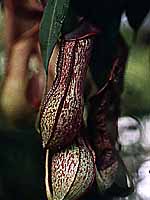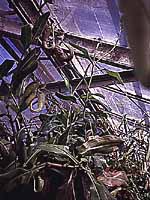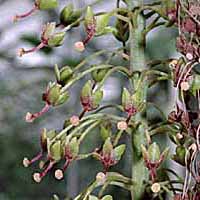 |
 |
 |
Nepenthales includes the Nepenthaceae (Asian pitcher plants) and the Droseraceae (flytraps & sundews).
In the photosynthetic autotrophic kingdom of plants, there are few among the green, leafy and inanimate that have evolved a certain taste for other organisms. These insectivorous heterotrophs, also known as the carnivorous plants, have been found all over the world in countless environments with one common characteristic. These plants attract, capture and consume prey. Nepenthes and members of Droseraceae are two examples of these unique multicellular organisms. Unfortunately for the world's insects, the main diet of these plants such as Nepenthes and Droseracereae consist of these extremely populous arthropods. Throughout their evolutionary history, these carnivorous plants have undergone adaptations that have enabled them to survive competition with other species over limited resources. Evidence in the fossil record reveals the existence of these plants during the early breakup of the great supercontinent Pangaea. Continental drift provided the vehicle for the dispersal of these unique plants to their present habitats all over the globe.
 |
 |
 |
Nepenthes (Asian pitcher plants) : Most species of Nepenthes are climbers or epiphytes, and all live in moist tropical forests. At left, the pitcher trap of Nepenthes alata, from the Philippines. The trap is mottled to look like a decaying animal, and has a "roof" that is not visible in the shadows above the pitcher. At center, several flowering plants of Nepenthes maxima, from Borneo. At right, a closeup of a "male" flower stalk. Individual plants produce either pollen or seeds throughout their lives but not both, meaning they are dioecious.
As with all traps in carnivorous plants, the trap must fool the insect into thinking the trap is a safe or desirable place to visit. The pitchers of Nepenthes are mottled, a pattern that insects associate with decaying flesh, and thus the pitcher looks like an easy meal. Scattered along the leaves and stems, are nectar glands that produce a sweet fluid whose presence and smell also attract insects. These glands are particularly dense around the mouth of the pitcher, but an insect trying to feed there will find that the lip of the pitcher is slippery and tumble into the witing trap.
Inside, pitcher traps are lined with many thousands of tiny wax scales. Because these scales are made to fall off easily on contact, insects attempting to grasp them while trying to escape will find their footing loose and slide further into the pitcher traps along the slippery surface. At the bottom of the trap is a pool of fluid containing digestive enzymes, where the hapless insects drown and are digested for their nutrients. Unlike other carnivorous plants in the Nepenthales, Nepenthes traps are reusable, and may trap many victims in the same pool of digestive fluid.
Although some organisms do live in the pitcher traps, the acidicity of the secreted digestive fluid prevents most microbes, fungi, slime molds, protozoa, diatoms, worms, larvae, nematodes and other species from living in the fluid. Because of the long time required to digest the trapped insects, Nepenthes often competes with other organisms such as spiders and primates for food. Spiders may build webs above the fluid in order to take advantage of the plant's attraction of insects, and thus rob the plant of its potential catches. Some primates engage in a similar activity of stealing insects that are found near the traps. In response, certain species of Nepenthes have evolved claws around the rim of their pitchers. These claws ward off would be predatory competition by making it unpleasant for any thief that might try to put an arm into the trap.
Unlike most flowering plants, Nepenthes is dioecious, producing unisexual flowers on separate plants. Pollen-producing flowers ("males") and seed-producing flowers ("females") are produced by different individuals. The flowers are greenish and are arranged in long slender clusters. The flowers offer nectar that is scentless, though the "male" flowers smell like rotting flesh, a scent that often attracts insects to the pollen for its distribution.
Dionaea muscipula, of the family Droseraceae, represents a carnivorous plant featuring a different method of predation. Dionaea muscipula is commonly known as the Venus flytrap. Instead of using a thick mucous lining to capture its preys, the Venus flytrap uses a quick reflex action to consume its prey. These plants are localized in the savannas of southeastern North Carolina and the neighboring eastern region of South Carolina. The plants grow among grasses and sedges and in areas with soil that is moist, sandy, and acidic.
 |
 |
 |
Drosera (sundews) and Dionaea (flytraps) : Most species of Drosera adelae from Queensland, Australia.
The traps of the Venus's flytrap consist of two clamshell-like halves. When opened, these traps are usually aligned 45 to 60 degrees apart if undisturbed. Venus flytraps use bright coloration, secretions of sweet nectar, or employ both to attract its preys. Each half of the trap has three smaller and finer trigger hairs in a triangular pattern. These hairs serve as a sensory indication to the plant signaling the arrival of potential prey. When insects brush against the triggering hair, the leaves of the plant close and insects are consumed and digested by the fluid secreted by this plant. Interestingly enough, an insect's struggle for existence within the confines of the flytrap is the stimulating factor toward the secretion of digestive fluid. Upon digestion, the nutrients extracted from the prey are absorbed at the bases of the glands for over 3 to 5 days depending on temperature and the size of the prey.
Reproduction in Droseraceae occurs through insect pollination and involves relatively small flowers that are usually characterized by white, violet, or red colors. However, perhaps because of its use of insects as food, the Venus flytrap has to produce many seeds. Drosophyllum, on the other hand, produces large flowers of a conspicuous yellow color. Large insects are used to pollinate the flowers of this plant and small insects are often consumed as prey. Therefore, Drosophyllum produces a small amount of large seeds because they utilize insects as vectors to maintain wide reproductive dispersal.
Both Nepenthes and the species of Droseraceae are living proof of evolution at work. More specifically, in the battle for habitat space, energy sources, and greater reproductive success, these plants represent the definition and exploitation of a new biological niche. With the advent of a plant metabolism equipped with extracting chemical energy from insects, these predatory plants opened a new niche defined by a new energy source. While most members of the Kingdom Plantae are photosynthetic autotrophs reliant on the sun for energy, these few evolved plants now have a wealth of energy in the form of insects, untouchable by other plants. This advantage in tapping energy sources grants Nepenthes and members of Droseraceae an advantage in reproductive success and again provides a real world illustration of evolution at work.

Sources:

